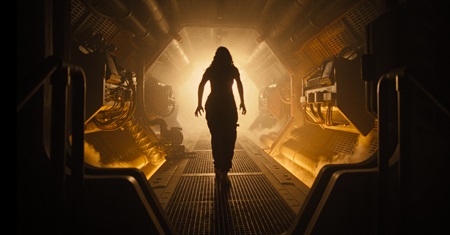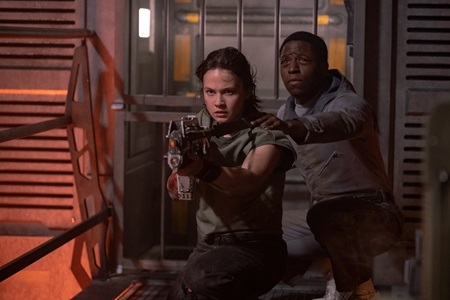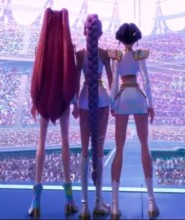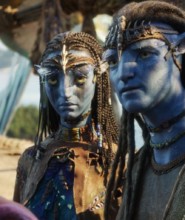
B-Grade Alien: Romulus is a Chest-Bursting Return to Xenomorph Basics
Considering it’s from Uruguayan filmmaker Fede Álvarez, the man behind 2013’s Evil Dead and 2016’s Don’t Breathe, I’m surprised how much Alien: Romulus plays it safe. Despite being filled with references to every entry in the long-running science fiction-horror series (including Prometheus and Alien Resurrection), and not skimping on the blood, guts, and stomach-churning viscera, there’s still something basic about it. Álvarez and his frequent co-writer Rodo Sayagues do not take many chances with this direct sequel to Ridley Scott’s 1979 classic Alien, and thus the picture’s staying power isn’t what it could have been.
That’s the bad news, but other than one technical facet deserving of further discussion (more on that later), there’s much here to celebrate: state-of-the-art visuals, stupendous practical effects, excellent gore, and strong performances from Cailee Spaeny and David Jonsson. More importantly, as a straightforward monster-in-a-haunted-house variation with an exceptionally high body count, Álvarez’s endeavor tends to be a lot of nasty fun.
Roughly 20 years after the destruction of the Nostromo, a group of twentysomethings decide they’re done following in the footsteps of their colonist parents by working for the Weyland-Yutani Corporation as little more than indentured servants. They embark on a clandestine raid of the derelict space station Romulus orbiting their planet, hoping to find functional hyper-sleep pods. This would allow them to make the nine-year journey to a distant Earth-like planet, where they’d be free to live life on their own terms. The risks would be worthwhile — or so they think.
Turns out, the reason Romulus is in shambles (and hours away from destruction) is because Weyland-Yutani was utilizing the station for illegal biological research involving the xenomorph creature Ellen Ripley blasted out of the Nostromo’s emergency shuttle’s doors two decades prior. The place is a decaying death trap for anyone unlucky enough to stumble aboard it, and all it takes is turning on the vessel’s primary functions to unleash a virtually unstoppable force of carnage unlike anything else in the universe.
While it’s not a wholly standalone entry in the franchise, Álvarez and Sayagues do keep the events of their story self-contained. Rising star Spaeny (fresh off Priscilla and Civil War) portrays Rain, a young woman trapped in company servitude, who sees boarding the Romulus with her more cavalier friends as leading to freedom. Jonsson is Andy, a hypersensitive synthetic whose functions are sadly starting to deteriorate and who has been programmed by Rain’s deceased parents to protect their daughter no matter what. The pair are the focal point around which everything else revolves. They are also excellent.
The rest of the ensemble is also made up of young, up-and-coming actors, including talented Dora and the Lost City of Gold star Isabela Merced and relative newcomers Archie Renaux, Spike Fearn, and Aileen Wu. All of them give solid performances, and each has a moment or two in which they’re allowed to shine. However, only Merced makes a lasting impression, and while her pluckily determined character isn’t exactly complex, the actor still brings a multifaceted gravitas to her portrayal that’s more than welcome.
There is one additional main character: the film’s primary villain, a synthetic being called “Rook,” badly mangled by some unseen event. As the ship’s science officer programmed to put the company’s needs before everything else, it’s par for the course that Rook considers Rain and her human compatriots to be fodder for the vesssel’s rampaging beasts.
The problem? First, there’s the dead-eyed motion capture. While the character of Rook is stunningly photorealistic and nearly as impressive as the primates in Kingdom of the Planet of the Apes or any of the Na’vi in Avatar: The Way of Water, there is still something creepily inert about it. It’s nearly as bad as the motion-capture elves of The Polar Express. While this synthetic is supposed to send chills up viewers’ spines, I’d guess that Álvarez meant for this to happen because of the robot’s actions and not due to its unsettling ocular emptiness.
The other issue is a personal one, and not every viewer will be bothered by it; it also ventures into spoiler territory. What I can say is that, from a performance standpoint, Daniel Betts, the facial and vocal actor partially responsible for Rook, does an outstanding job. But, much like Rogue One: A Star Wars Story, it’s the character’s appearance that will generate the most chatter. While I am impressed with how much the technology has progressed since that 2016 box office smash, seeing a legendary — and deceased — actor resurrected via digital technology still makes me uncomfortable.
Still, Álvarez is flying fast and loose here, and suffice it to say, his energetic creative vivaciousness does tend to be infectious. While never as lofty as the three installments handled by Scott or those by James Cameron (Aliens), David Fincher (Alien3), or Jean-Pierre Jeunet (Alien Resurrection), this spin-off is like one of those B-movie 1930s,’40s, and ’50s Universal Monsters sequels (think Son of Dracula, The Ghost of Frankenstein, or Revenge of the Creature). Or a Vincent Price–starring William Castle opus crossed with a Roger Corman–produced 1980s sci-fi cheapie mixed with a Luigi Cozzi low-budget Italian rip-off, only with major Hollywood studio production values and performances. These are all positives in my book.
Maybe I’m biased, but I don’t think there are any “bad” Alien installments (well, maybe Alien vs. Predator: Requiem, but we can debate whether that should be part of the discussion another time). While there are only two bona fide classics (Alien and Aliens), every film in the series has its merits, and I find all of them enjoyable.
While Alien: Romulus is arguably the most disposable chapter in the xenomorph’s ongoing chest-bursting adventures, and even though it contains a creative element I found uncomfortably dubious, I still walked out of my IMAX showing with a smile on my face. Cinematographer Galo Olivares does stellar work, and Álvarez knows how to craft genuine thrills and chills. He’s near the top of his game generating each sensation in this sequel. Thankfully, that was good enough for me.
– Review reprinted courtesy of the SGN in Seattle
Film Rating: 3 (out of 4)








